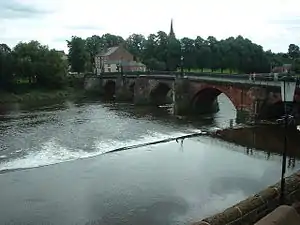Chester Weir
Chester Weir is a weir which crosses the River Dee at Chester, Cheshire, England, slightly upstream from the Old Dee Bridge (grid reference SJ407658). The weir and the associated salmon leap are recorded in the National Heritage List for England as a designated Grade I listed building.[1]

This was originally the site of a causeway across the River Dee. The weir was built in sandstone in 1093 for Hugh Lupus, 1st Earl of Chester, for the Benedictine Abbey of St Werburgh (now Chester Cathedral). It was designed to provide a head of water for the medieval mills on the river. The mills were demolished during the 20th century and the weir was restored to serve the Chester City Council's hydro-electric power station, which operated from 1913 to 1939 on the site of the former mills.[1]
The weir continues to provide three essential roles in maintaining the very substantial water abstractions from the River Dee. It prevents tidal water ingress up-river for all but the highest tides; it provides the water head for an abstraction immediately behind the weir and it holds back what is a long linear lake which enables that largest abstraction to be taken at Huntington for the United Utilities supply to the Wirral and surrounding areas.[2]
The weir can be navigated by crossing over the top during high spring tides. On the city-side of the weir is the United Kingdom's only example of a weirgate, a low height single lock gate that can be opened to provide extra draft once the water levels on each side of the weir have equalised.[3] This allows carefully planned passage from the non-tidal River Dee, via the short tidal estuary section, onto the Dee Branch of the Shropshire Union Canal (originally the Chester Canal) at certain times of year.[4]
United Utilities vacated the turbine building in 2015, ending its use as a pump station, and allowing installation of a new hydro electric generating plant, planning for which is underway as of 2021, alongside a Green-Energy education centre and visitor attraction. [5][6]
References
- Historic England, "Chester Weir and Salmon Leap (1375691)", National Heritage List for England, retrieved 22 March 2015
- AU: G. S. TAYLOR, P. HILLIS, I. WALKER TI: Pilot-Plant Trials on River Dee Water at Huntington SO: Water and Environment Journal VL: 7 NO: 4 PG: 333-342 YR: 1993 ON: 1747-6593 PN: 1747-6585 AD: Research Manager and Research Assistant, respectively, Research and Technical Development, Huntington WTW, North West Water Ltd.; Technical Specialist, Water Treatment Group, WRc. doi:10.1111/j.1747-6593.1993.tb00854.x
- Chester Weir and Dee Bridge, retrieved 22 May 2009,
Special Arrangements are needed to navigate through the gate in the weir at a suitable tide.
- Boating along the River Dee (Cheshire), British Waterways, retrieved 22 May 2009,
For boats wanting to pass between the non-tidal section and the Shropshire Union, there is a tricky weir passage that can only be made at certain states of the tide. You will also need to book passage through the locks of the Dee Branch.
- Century Old Hydro-Electric Power Station May Be Brought Back Into Use, Handbridge.com, archived from the original on 6 March 2016, retrieved 27 May 2012,
The former hydro-electric power station on the Old Dee Bridge may again generate power for the first time since the second world war.
- "Chester's old hydroelectric power station to be turned into "thriving visitor attraction"".